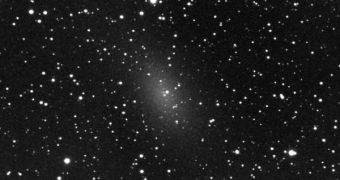Dwarf spheroidal galaxies (dSph) are among the most peculiar types of galaxies in the Universe. The low luminosity formations have first been observed as companions to the Milky Way and to the Andromeda Galaxy (M31), but understanding how they formed and where they came from is one of the most long-standing mysteries in modern astronomy. Writing in the latest issue of the journal Nature, a team of astrophysicists from the Harvard-Smithsonian Center for Astrophysics proposes a possible formation method for these peculiar structures.
One unique trait about dSph is that they have very few stars in comparison to their mass. This has led astronomers to assume that a large part of their weight is given by the elusive dark matter, although no firm scientific evidence have been discovered to support this yet. According to previous studies, the mass of dark matter – which is only detectable through the gravitational pull it exerts on normal matter – outweighs that of matter we can see by a factor of five to one.
In other works, astronomers have inferred that dwarf spheroidal galaxies form on the outskirts of more massive ones, such as our own Milky Way, but that explanation cannot account for why they appear outside the “Local Group,” which is the name given to the cluster of galaxies in our vicinity. “These systems are 'elves' of the early universe, and understanding how they formed is a principal goal of modern cosmology,” Harvard-Smithsonian Center for Astrophysics (CfA) expert Elena D'Onghia, the lead author of the Nature paper, explains.
The scientist and her colleagues used a series of computer simulations to test two scenarios of how dSph formed, which experts believe are the most probable – an encounter between two dwarf galaxies far from giants like the Milky Way, with the dwarf spheroidal galaxy later accreted into the Milky Way, and an encounter between a dwarf galaxy and the forming Milky Way in the early universe. According to the results, galactic encounters were the only scenarios that resulted in a gravitational process called “resonant stripping.” This means that, while the collision took course, most stars from the dwarf galaxy were taken into the larger one, therefore only a dwarf spheroidal galaxy remained.
“Like in a cosmic dance, the encounter triggers a gravitational resonance that strips stars and gas from the dwarf galaxy, producing long visible Tails and bridges of stars,” D'Onghia says. “This mechanism explains the most important characteristic of dwarf spheroidals, which is that they are dark-matter dominated,” Gurtina Besla, the co-author of the Nature study, adds.

 14 DAY TRIAL //
14 DAY TRIAL //